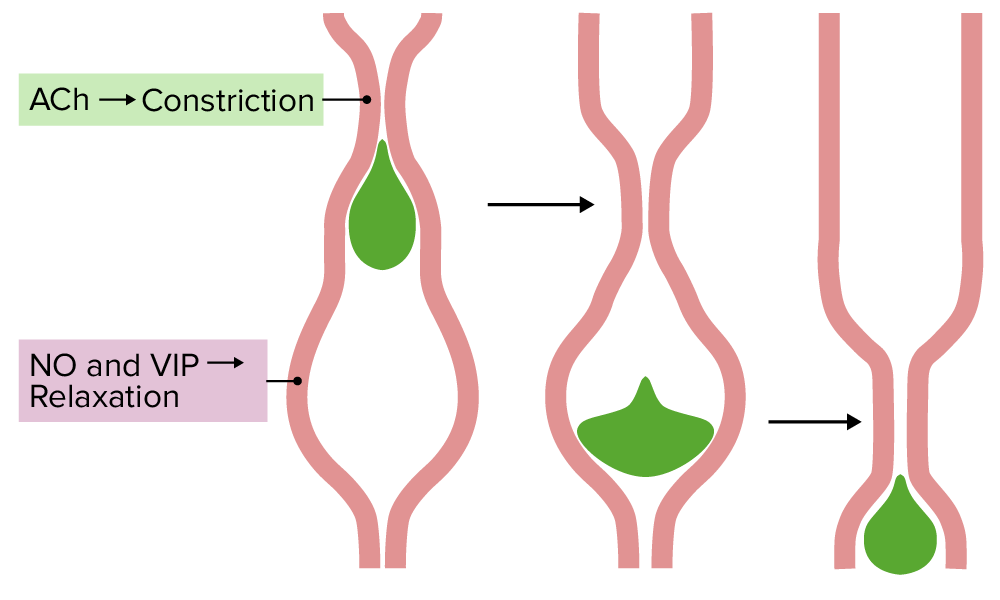Playlist
Show Playlist
Hide Playlist
Gastric Motility – Gastrointestinal Motility
00:01 Now that we have food into the stomach, let’s first talk about the top portion of the stomach that relaxed to be able to get the food into it. 00:11 So this is the lower esophageal sphincter and the cardia. 00:15 This is where food enters into the stomach and it’s also the place in which you can regulate belching or releasing air. 00:25 The fundus or body of the stomach. 00:27 This acts mainly as reservoir or holds food, but it also houses some very unique cells called interstitial cells of Cajal. 00:37 These are the pacemaker cells for slow waves within the stomach. 00:44 The final areas of the stomach are the lower portions and this is the antrum, which is the lower portion of the stomach, and finally, the pylorus. 00:52 And the pylorus will have the sphincter that will release or allow for the release of stomach contents into the small intestine in the upper portion known as the duodenum. 01:04 But the antrum serves another very important aspect. 01:07 It actually uses its contractions to help mix and grind food because remember you’re releasing a lot of fluid, you’re releasing hydrogen ions, you’re releasing pepsin and therefore, you need to mix all those together before you can get complete digestion of certain aspects in the stomach. 01:30 To show this in a little bit more detail, I can use this particular diagram. 01:35 Here, you can see one particular contraction. In this case, contraction A. 01:39 As it contracts, it moves some food stuff towards the pyloric sphincter. 01:44 But the other portion is pushed backwards. 01:48 We put in a second contraction. 01:51 A little bit of it gets pushed forward and even more gets pushed backwards. 01:55 And finally, a third contraction does the same thing. 01:59 Some gets pushed forward and some backwards. 02:02 This backwards and forwards contractions allow for that mixing process to happen. 02:09 Interestingly though, as you do that mixing, a little bit usually gets pushed through the pyloric sphincter because there is enough pressure to move past that. 02:18 So a little bit gets moved past into the small intestine and the rest of it gets mixed. 02:25 As you continue contracting, you continue that mixing movement. 02:33 Okay, now that we’ve reached the topic of some of the substance in the stomach moves past the pyloric sphincter, you might ask, “Well, what regulates that process? And how do we know what things can move past the pyloric sphincter the fastest?" To look at this, we can have a graph where we’re graphing time on the X-axis and on the Y-axis, it’s the time remaining in the stomach. 02:59 Hopefully, you can see from this kind of graph that a liquid is emptied faster than a solid food. 03:08 Also, something that has a high amount of glucose is emptied before something that has higher amounts of protein. 03:16 And the reason why this is an important process is that certain foods will stay in the stomach longer. 03:22 If it is sold and if it has a high protein concentration, those things will stay in the stomach longer, than if it is liquid and has a high glucose concentration. 03:35 So we can digress this process about fats, proteins, and carbohydrates in this format. 03:41 Carbohydrates are emptied first, followed by proteins, and finally, fats. 03:47 Liquids are emptied faster than solids. 03:52 And if you have a high osmolality, you will delay gastric emptying And what do I mean by high osmolality? That has a high sodium concentration and that usually delays the amount of gastric emptying that occurs.
About the Lecture
The lecture Gastric Motility – Gastrointestinal Motility by Thad Wilson, PhD is from the course Gastrointestinal Physiology.
Included Quiz Questions
Which type of food substance will empty from the stomach first?
- Liquids with a high carbohydrate concentration
- Liquids with a high protein concentration
- Solids with a high protein concentration
- Solids with a high carbohydrate concentration
- Liquids with a high-fat concentration
Which of the following is a function of the antrum of the stomach?
- Mixing and grinding of food
- Act as a food reservoir
- Allows food entry into the stomach
- Regulation of belching
- Regulate slow waves of the stomach
Customer reviews
5,0 of 5 stars
| 5 Stars |
|
5 |
| 4 Stars |
|
0 |
| 3 Stars |
|
0 |
| 2 Stars |
|
0 |
| 1 Star |
|
0 |




